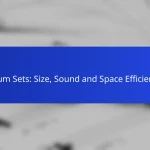What are the best musical instruments for beginners?
The best musical instruments for beginners are those that are easy to learn, affordable, and versatile. Instruments like the guitar, piano, drums, and ukulele provide a solid foundation for new players, allowing them to develop their skills and explore various musical styles.
Guitar options for beginners
For beginners, acoustic guitars are often recommended due to their simplicity and affordability. Brands like Yamaha and Fender offer models that are well-suited for new players, typically priced between $150 and $300. Consider a guitar with a comfortable neck and light gauge strings to make learning easier.
Electric guitars can also be a good choice, especially for those interested in rock or pop music. Look for starter packs that include an amplifier and accessories, usually available for around $200 to $400. This option allows beginners to experiment with different sounds and styles.
Piano choices for new players
Digital pianos and keyboards are ideal for beginners, providing a range of features and sounds. Models from brands like Casio and Yamaha start at about $300 and can go up to $800, depending on the number of keys and additional functions. Look for weighted keys to simulate the feel of an acoustic piano.
Consider a portable keyboard if space is a concern. These typically have fewer keys and are lighter, making them easier to transport. Prices for beginner keyboards can range from $100 to $300, making them accessible for most new players.
Drum kits suitable for novices
For beginners interested in drumming, electronic drum kits are often recommended due to their quiet operation and built-in learning features. Brands like Alesis and Roland offer kits starting around $300, which include practice modes and various sounds.
Acoustic drum kits can also be suitable but may require more investment and space. A basic entry-level acoustic kit can cost between $400 and $800. Beginners should consider the noise factor and whether they have a suitable practice space.
Ukulele recommendations for starters
The ukulele is a fantastic choice for beginners due to its small size and light weight. Soprano and concert ukuleles are popular options, with prices typically ranging from $50 to $200. Brands like Kala and Mahalo offer quality instruments that are easy to play and tune.
When selecting a ukulele, look for one made from quality materials, as this can affect sound and durability. A starter pack that includes a tuner and instructional materials can enhance the learning experience without breaking the bank.
How do musical instrument prices compare?
Musical instrument prices vary significantly based on type, brand, and quality. Understanding these price ranges can help you make informed purchasing decisions whether you are a beginner or an experienced musician.
Price ranges for guitars
Guitar prices typically range from around $100 for entry-level models to several thousand dollars for high-end instruments. Factors influencing price include the brand, materials used, and craftsmanship.
For example, a decent acoustic guitar for beginners might cost between $150 and $500, while professional-grade guitars can exceed $2,000. Electric guitars often fall within similar price brackets, with budget options starting around $200.
Piano pricing breakdown
Piano prices can vary widely, starting from about $300 for basic digital models to over $100,000 for grand pianos. The type of piano—digital, upright, or grand—greatly affects the cost.
Digital pianos generally range from $300 to $1,500, while upright pianos can cost between $3,000 and $10,000. Grand pianos, known for their superior sound quality, typically start around $7,000 and can go well beyond $100,000 for concert models.
Cost comparison for drum kits
Drum kit prices range from approximately $300 for entry-level sets to over $5,000 for professional configurations. Factors such as the number of pieces, brand, and materials contribute to the overall cost.
An average beginner’s drum kit might cost between $400 and $800, while intermediate kits can range from $800 to $2,000. Professional drum sets, especially those made from premium woods, can easily exceed $3,000.
Ukulele price analysis
Ukulele prices are generally more affordable, ranging from about $30 for basic models to $500 or more for high-quality instruments. The size, brand, and materials used play a significant role in pricing.
Entry-level soprano ukuleles typically cost between $30 and $100, while concert and tenor ukuleles can range from $100 to $300. Premium ukuleles, often crafted from exotic woods, may start around $300 and go up to $1,000 or more for custom models.
What are the top-rated musical instruments in 2023?
In 2023, the top-rated musical instruments include electric guitars, acoustic pianos, drum sets, and ukuleles, each known for their quality, sound, and playability. Musicians often consider factors such as brand reputation, user reviews, and specific features when selecting their instruments.
Best electric guitars of 2023
This year, some of the best electric guitars are characterized by their versatility and sound quality. Models like the Fender Stratocaster and Gibson Les Paul continue to receive high praise for their craftsmanship and tonal range.
When choosing an electric guitar, consider the type of music you play, as different guitars excel in various genres. For example, solid-body guitars are often preferred for rock, while semi-hollow and hollow-body guitars are favored for jazz and blues.
Top acoustic pianos this year
In 2023, top acoustic pianos are recognized for their rich sound and responsive touch. Brands such as Steinway & Sons and Yamaha are frequently recommended for their reliability and exceptional performance.
When selecting an acoustic piano, think about the size of the instrument and the space available in your home. Grand pianos offer superior sound but require more room, while upright pianos are more compact and suitable for smaller spaces.
Highly rated drum sets
This year, highly rated drum sets include options from brands like Pearl and Ludwig, known for their durability and sound quality. These sets often come in various configurations, catering to different playing styles and skill levels.
When purchasing a drum set, consider the number of pieces you need. A standard five-piece set is versatile for most genres, while a three-piece set may be sufficient for beginners or those playing simpler styles.
Popular ukuleles of 2023
In 2023, popular ukuleles are appreciated for their portability and ease of play. Brands like Kala and Lanikai are often highlighted for their quality craftsmanship and vibrant sound.
When choosing a ukulele, consider the size that best fits your playing style. Soprano ukuleles are great for beginners due to their smaller size, while concert and tenor ukuleles provide a fuller sound and are preferred by more experienced players.
What features should I consider when buying a musical instrument?
When buying a musical instrument, consider sound quality, durability, and brand reputation. These features significantly impact your playing experience and the instrument’s longevity.
Sound quality factors
Sound quality is crucial when selecting a musical instrument. Look for characteristics like tone, volume, and resonance, which vary by instrument type. For example, a well-crafted acoustic guitar should produce a rich, balanced sound across its range.
Testing the instrument in person can help you assess its sound quality. If possible, play different models side by side to hear the differences. Pay attention to how the instrument responds to your playing style and preferences.
Durability and build quality
Durability and build quality are essential for ensuring your instrument withstands regular use. Instruments made from high-quality materials, such as solid wood or metal, typically offer better longevity. For instance, a solid body electric guitar is generally more robust than a hollow body model.
Inspect the craftsmanship, including joints, finishes, and hardware. Instruments with good build quality often come with warranties, which can provide additional peace of mind. Avoid instruments that feel flimsy or have visible defects.
Brand reputation and reviews
Brand reputation plays a significant role in your purchase decision. Established brands often have a history of producing reliable instruments, while newer brands may still be proving their quality. Research brands known for their craftsmanship and customer service.
Reading reviews from other musicians can provide insights into the instrument’s performance and reliability. Look for reviews that discuss long-term use and customer experiences. Websites and forums dedicated to musicians can be valuable resources for gathering opinions and recommendations.
How do I choose the right musical instrument for my needs?
Choosing the right musical instrument involves assessing your skill level, understanding your goals, and considering practical factors like space and budget. This process ensures you select an instrument that aligns with your personal preferences and lifestyle.
Assessing skill level and goals
Your skill level plays a crucial role in selecting a musical instrument. Beginners may benefit from instruments that are easier to learn, such as ukuleles or keyboards, while more experienced players might seek out advanced options like electric guitars or violins.
Consider your musical goals as well. Are you looking to play casually, join a band, or perform professionally? Your objectives will guide your choice, as some instruments are better suited for specific genres or performance settings.
Considering space and portability
Space and portability are important factors when choosing a musical instrument. If you live in a small apartment, consider compact instruments like a keyboard or a travel guitar that can easily be stored. Larger instruments, such as pianos or drum kits, require more space and may not be practical for every living situation.
Portability is also key if you plan to take your instrument to lessons or gigs. Instruments like flutes or acoustic guitars are lightweight and easy to transport, while larger instruments may require additional effort and equipment for safe transport.
Evaluating budget constraints
Your budget will significantly influence your instrument choice. Entry-level instruments can range from a few hundred to several hundred USD, while professional-grade options can cost thousands. Set a budget that reflects your commitment level and financial situation.
Consider not only the initial purchase price but also ongoing costs such as maintenance, accessories, and lessons. It’s wise to allocate funds for quality accessories, as they can enhance your playing experience and prolong the life of your instrument.
What are the differences between acoustic and electric instruments?
Acoustic instruments produce sound naturally through vibration, while electric instruments rely on electronic amplification. The choice between them often depends on the musical style, performance setting, and personal preference.
Sound Production
Acoustic instruments create sound through physical means, such as strings vibrating in a hollow body or air being blown through a tube. Examples include guitars, violins, and flutes. In contrast, electric instruments generate sound electronically, using pickups and amplifiers to enhance the sound. Electric guitars and keyboards are common examples.
Portability and Setup
Acoustic instruments are generally more portable since they do not require additional equipment for sound production. This makes them ideal for outdoor performances or casual jam sessions. Electric instruments, however, often need amplifiers and other gear, which can complicate setup and transportation.
Versatility and Effects
Electric instruments offer greater versatility in sound manipulation, allowing musicians to use effects pedals and software to alter their sound significantly. Acoustic instruments typically have a more limited range of tonal options, relying on the natural sound of the instrument. However, many musicians appreciate the authenticity and warmth of acoustic sounds.
Cost Considerations
Acoustic instruments can range from affordable beginner models to high-end professional options, often starting in the low hundreds of USD. Electric instruments may have a similar price range, but additional costs for amplifiers and effects can increase the overall investment. It’s essential to budget for both the instrument and any necessary accessories.






